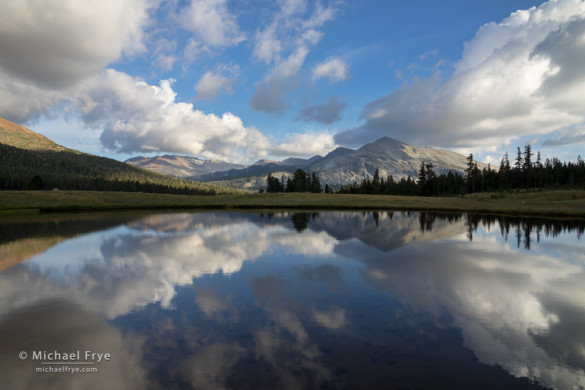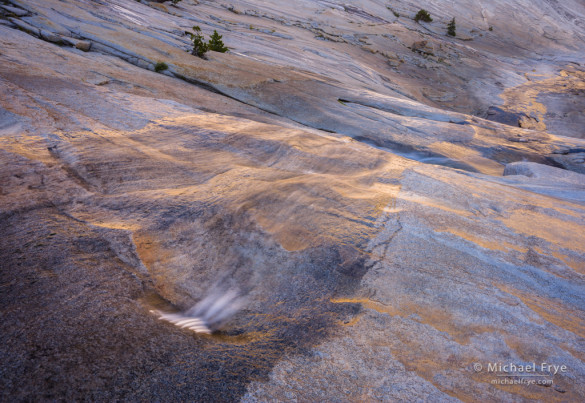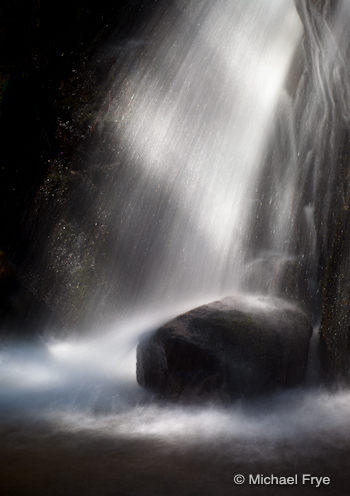by Michael Frye | Jul 26, 2015 | Photography Tips

Clouds and Mammoth Peak reflected in an alpine tarn, Yosemite (1/90th of a second)
I love mirror reflections. The symmetry they create, with the bottom of the photograph mimicking the top, almost automatically adds repetition and creates patterns, helping to unify the image and give it rhythm.
The photograph above is a good example. I made this about two weeks ago near Tioga Pass, with some fantastic clouds passing by late in the afternoon. It’s not a perfect mirror, as the water is slightly rippled, but it’s close enough. The clouds and their reflections form a big X through the picture, a pattern that echoes some of the diagonals in the mountains. This design draws your eye from the middle of the frame out to the corners, giving the image a sense of dynamic energy. None of that would happen without the mirror reflections.
On the other hand, I love rippled water too. (more…)
by Michael Frye | Jul 23, 2013 | Light and Weather, Photography Tips, Vision and Creativity

Creek descending through a granite basin. The sun was hitting the rocks just beyond the top of the frame, reflecting the gold color into the water, and even onto some of the polished rocks on the right.
When people think of photographing a reflection, they usually think of a mirror reflection, like a mountain reflected in a tranquil lake. I’ve done my share of those, but I think it’s often more interesting to just look at the colors, textures, and patterns on the water’s surface.
During my just-completed Hidden Yosemite workshop we had many opportunities to photograph reflections of all kinds. The accompanying photographs represent a mini-gallery of reflection photographs that I made during and just prior to the workshop, with extended captions to explain the thought process behind each image. Most of these are not mirror reflections; instead, they’re focused on the water’s colors and textures.
(more…)
by Michael Frye | Mar 9, 2012 | Photography Tips, Vision and Creativity

Small waterfall in Yosemite Valley, high noon
Everyone develops routines and habits: waking up at the same time every day, eating the same thing for breakfast, taking the same route to work… and on and on. Routines are beneficial in some ways—they help us avoid spending time and energy making small, unimportant decisions every day.
In photography, routines can help with the technical, left-brained stuff. Always putting lens caps in the same place in your camera bag, or the same pants pocket, can help save time and avoid frustration. Checking off a mental list before pressing the shutter can prevent mistakes. Did you adjust the polarizer? Focus? Set the right aperture? Shutter speed? Did you check the histogram? What’s your ISO?
But routines also dull the senses, and in photography that can be deadly. I’ve photographed this small waterfall in Yosemite many times, but always in the shade. Soft light works well for subjects like this—it makes it easy to use slow shutter speeds, and simplifies the lighting. So I’d never even considered visiting this spot when sunlight was hitting the water.
Last weekend I was shooting footage for some instructional videos in Yosemite Valley. I wanted to talk about using slow shutter speeds with moving water, but the crew only had one day in Yosemite, and the schedule only allowed us to visit this waterfall at noon. As we approached the fall I thought, hmm, this might work. Backlight filtering through the trees created some interesting patterns, and as the sun moved it started to highlight just the right spots. As I was demonstrating how different shutter speeds affected the appearance of the water, I was looking at the images on my viewfinder and thinking, “Wow, that looks pretty cool!”
(more…)











